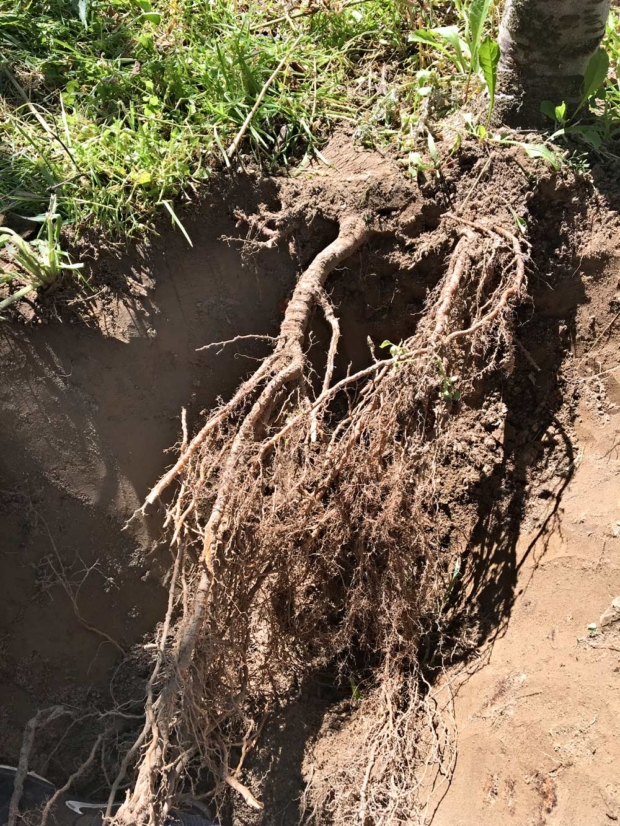
A healthy root system is key to ensuring that your trees can absorb the nutrients you are applying, according to Bernadita Sallato, orchard manager for Washington State University’s Cherry Breeding Program.(Courtesy Bernardita Sallato)
Without proper nutrition, cherry trees can suffer from low yield, small fruit, poor quality and higher disease and decay susceptibility, but over-applying needed nutrients creates unnecessary fertilizer bills and, at extreme levels, can have toxic effects.
With all plant nutrients, there’s a critical concentration needed to ensure growth and prevent deficiency. But many growers inadvertently go well past that point, and in this case, more is not better, according to Bernardita Sallato, Washington State University cherry breeding program manager.
“If we keep adding more nutrients (past the recommended level), we get to a point where we have a luxury of consumption. It doesn’t damage the crop per se, but it’s a waste of money,” she said. “If we don’t do a proper nutrient diagnostic of our orchard, we might make the wrong decision to manage it.”
At the extreme of over-application, there can be toxic effects from needed nutrients, but it can also contribute to reduced shelf life and some post-harvest disorders.
Giving your trees just what they need and not more requires careful calculation. To help growers get it right, Sallato explained her nutrient needs diagnostic strategy at the Cherry Institute in Yakima, Washington, in January. She suggested taking these steps:
—The equation for the correct dose is the difference between the trees’ nutrient demand and the existing supply in the orchard, divided by the efficiency, which varies with the application method, orchard management and soil type.
—Putting that equation into practice requires calculating your nutrient demand based on yield. For every ton of cherries harvested, trees use between 4 to 7 pounds of nitrogen and potassium, and 0.4 to 0.7 pounds of phosphorus, Sallato said. Every orchard is a little different, but the accurate demand can be determined by an analysis of soil type, soil chemistry and water inputs, she said.
—Then, you have to determine the supply available to your trees. That includes the nutrients available in the soil, the water inputs and the organic matter. Soil tests work well for phosphorus and potassium, but nitrogen does not accumulate in the soil, so Sallato recommends measuring soil organic matter and the nitrate levels in your water.
—The efficiency with which your trees can take up new nutrients depends on your irrigation practices, your soil type and root development. For nitrogen, orchards that are rill irrigated or have coarse sandy soils have about a 40 percent efficiency, while drip irrigation can reach 70 percent efficiency, Sallato said.
Sallato gave the following example of how to put that math together. For cherries using 7 pounds of nitrogen for every ton harvested, an orchard producing 8 tons of cherries per acre has a nitrogen demand of 56 pounds per acre. Then, if the soil organic matter is about 1.5 percent, that supplies about 14 pounds of nitrogen per acre, which means you need to get your trees another 42 pounds. Considering 70 percent efficiency in an irrigated orchard, you’d need to apply 60 pounds per acre to ensure that the trees get the 42 pounds they need.
Taking tissue samples for nutrient analysis allows you to verify that nutrients are being absorbed, what shortages still exist and changes to be made.
If observations or analysis indicate that your orchard is suffering from a nutrient deficiency, it’s important to investigate underground as well, Sallato said. She discovered root problems last year in WSU’s own cherry block after soil tests showed an excess of phosphorous and potassium but analysis of the leaf tissue indicated that the tree was deficient in both nutrients.
“It was quite evident that we had a problem with the root density,” she said. “It doesn’t matter what we have in the soil, if the plant is not absorbing it, we’ll have a sick plant.”
She also cautioned that while nutrients are critical for tree health, they compose just a small part of the plant’s biomass. Don’t get so focused on optimizing nutrition that you miss the big picture. “If we don’t pay attention to irrigation and light, nothing we do with nutrition will make a difference,” Sallato said. •






Leave A Comment